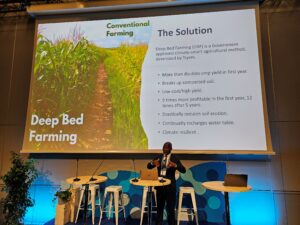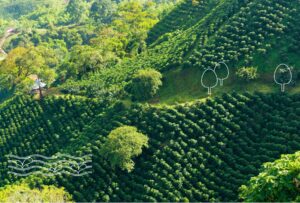Some of the most important ecological processes of securing water and food happen out of sight — in forest canopies, soils and root systems. A comprehensive new report, with SIWI contributing scientific leadership to Chapter 4, shows how these natural processes regulate moisture, climate and water quality. Acknowledging these forest-water functions is now critical for creating agricultural plans that are fit for a more unpredictable climate.
For years, forests and agriculture have often been seen as competing for space and resources, like water. The new report Climate and ecosystem service benefits of forests and trees for agriculture reveals a far more connected relationship. Developed by FAO, SEI, The Nature Conservancy and Conservation International — alongside a broad group of contributing authors — it shows how forests and trees sustain the systems that support farming: shaping rainfall, cooling fields, protecting soils, supporting pollinators and safeguarding rural workers from extreme heat. Rather than opposites, forests and agriculture are intertwined, which is especially important in a changing climate.
From this broader narrative, Chapter 4 turns the focus specifically to water — the thread that connects forests and agriculture most directly. Co-led by Malin Lundberg Ingemarsson, PhD, Advisor Water Climate and Environment at SIWI and Aida Bargués Tobella, Researcher at SLU/Agrotecnio, the chapter shows how forests and trees are crucial for soil moisture, groundwater, streamflow, humidity and water quality, making them central to productive and climate-resilient farming.
Understanding the forest–water connection
Forests regulate water in ways that shape entire landscapes. Roots draw moisture from the soil and release it through transpiration to the atmosphere; canopies intercept rainfall and decrease below temperatures; and leaf litter improves soil structure. These processes determine how much water infiltrates the ground, how steadily it flows through ecosystems, and how clean it is when it reaches communities, farms, and rivers.
In practice, forests influence how much water is available, when it reaches crops, how it moves through soils and the quality of the water that flows downstream. When these functions weaken, agricultural systems feel the impact immediately.
Green water: the invisible blood stream of the global food production
While blue water refers to the rivers, lakes and groundwater used for irrigation, green water is the soil moisture plants draw on directly — and it underpins all rainfed farming. Forests and trees are crucial for maintaining this moisture. They increase infiltration, improve the soil’s capacity to store water, and create shade that reduces evaporation. In water-limited landscapes, these functions are central to agricultural resilience.
Forests also help regulate blue water — the rivers, lakes and aquifers used for irrigation. By absorbing rainfall rather than allowing it to rush across the surface, forest soils reduce flooding, support groundwater recharge, and moderate streamflow. In degraded forest areas, these functions are hampered or lost, and even small-scale water-smart restoration can significantly improve infiltration, soil quality, and soil moisture.
Forests shape rainfall and protect water quality
Forests influence rainfall at scales far beyond their boundaries. Through transpiration, tree-covered areas release moisture that helps form clouds and drive precipitation, sometimes hundreds of kilometres away. When forests are degraded or lost, local climate becomes hotter and drier, with less predictable weather, causing direct consequences for local and down-wind crop yields.
Forests also act as natural filters. Their roots, litter and soils trap sediments and pollutants, while riparian forests stabilize riverbanks and reduce erosion. Cleaner water supports healthy crops and lowers the costs of maintaining irrigation systems.
Climate change and the growing urgency of forest protection
Climate change amplifies every vulnerability within food and water systems. Extreme rainfall events carries away exposed and degraded soils while prolonged droughts hit hardest where landscapes are unable to retain moisture. Heatwaves threaten both crops and farm workers in areas with limited tree cover.
Forests provide a natural protection. They cool landscapes, enhance soil moisture, support local rainfall and buffer against extremes. Without them, both green and blue water become less reliable, and food production becomes increasingly fragile.
Green water in SIWI’s work
The insights from Chapter 4 reflect a growing recognition in the water community that green water must become part of mainstream water governance. For SIWI, this has been an emerging priority: helping partners understand how soil moisture, landscape integrity, and rainfed agriculture fit into climate adaptation and long-term water resilience. Forests and tree systems are a core part of this picture. Their influence on infiltration, soil structure, and rainfall formation illustrates why green-water management cannot be separated from land-use decisions. As SIWI continues to strengthen its focus on green water, the report provides valuable evidence and underscores the need for integrated approaches that connect forestry, agriculture and water governance.
What needs to happen
To strengthen food and water security, the report highlights several priorities:
- Integrate forest, land and water management across whole landscapes.
- Recognize the critical role of forests and trees in both green- and blue-water systems
- Restore degraded lands to improve soil moisture, infiltration, and water quality.
- Invest in monitoring of soil moisture, rainfall patterns, and water flows.
- Scale up agroforestry and other tree-based farming systems that build resilience.
- Improve coordination across water, agriculture, forestry and climate institutions.
- Combine scientific knowledge with local and Indigenous expertise.

Key take-aways
– Forests and trees have a key role in regulating the hydrological cycle. – Their influence ranges from soil moisture and groundwater to rainfall, cooling and water quality. – Deforestation and forest degradation undermines water security and agricultural resilience. – Restoring forests can strengthen food systems in a changing climate. – Integrated governance – like a landscape approach – is essential to protect these interconnected systems.








